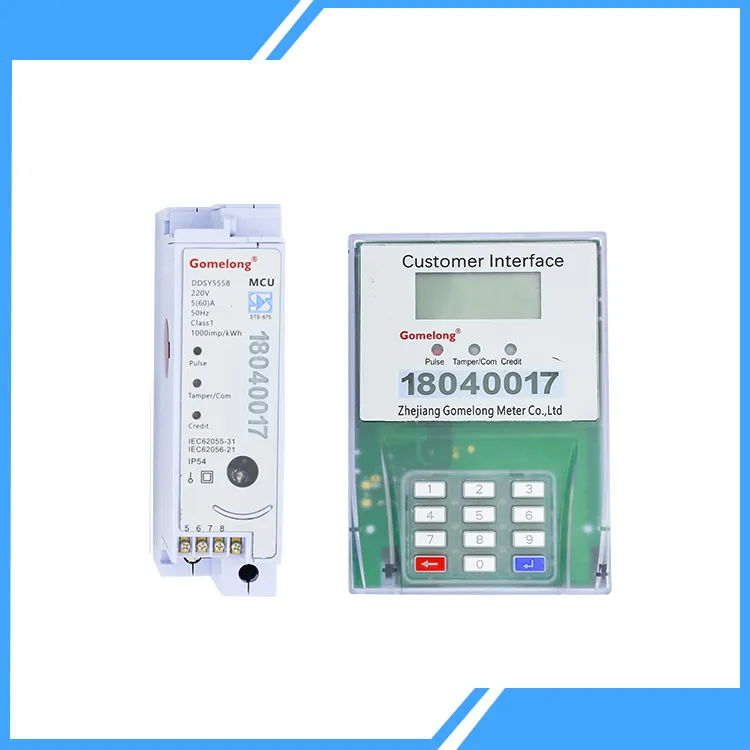Information about STS Split Din Rail Energy Meters
2024-07-28
An STS (Standard Transfer Specification) split DIN rail energy meter is a device used for measuring and monitoring electrical energy consumption in a standardized and modular format. The STS standard ensures compatibility and interoperability for energy metering systems. Here’s an overview of STS split DIN rail energy meters:
Key Features:
1. DIN Rail Mounting:
- Modular Design: Designed to be mounted on DIN rails (standardized metal rails used for mounting electrical devices in enclosures) for easy installation and integration.
- Compact Size: Typically compact and modular, allowing for easy integration into electrical panels or distribution boards.
2. STS Standard:
- Standard Transfer Specification (STS): Complies with the STS standard for energy metering, ensuring compatibility and interoperability with various energy management systems and prepayment systems.
- Data Communication: Supports data transfer and communication in accordance with STS standards for accurate and reliable energy metering.
3. Energy Measurement:
- Parameters: Measures various electrical parameters including active energy (kWh), reactive energy (kVARh), and apparent energy (kVAh).
- Accuracy: Provides accurate readings of energy consumption, often with high precision.
4. Display and Communication:
- Display: Equipped with an LCD or LED display to show real-time readings of energy consumption and other parameters.
- Communication Interfaces: May include communication interfaces such as RS-485, Modbus, or pulse outputs for integration with building management systems or energy management software.
5. Prepayment Functionality:
- Token-Based: Some STS meters include prepayment functionality, allowing users to load energy credits or tokens and monitor consumption against the prepaid amount.
- Account Management: Supports various prepayment methods and can be integrated with vending systems for token generation.
6. Advanced Features:
- Load Profiling: Some models offer load profiling to analyze energy consumption patterns over time.
- Data Logging: Capable of storing historical data and consumption records for analysis and reporting.
Applications:
1. Commercial and Industrial:
- Energy Management: Used in commercial and industrial settings to monitor and manage energy consumption, optimize energy usage, and ensure efficient operation.
- Submetering: Useful for submetering specific areas or equipment within larger facilities.
2. Residential:
- Energy Monitoring: Used in residential applications to monitor and manage energy consumption, often in conjunction with home automation systems.
3. Utilities:
- Billing: Utilized by utilities for accurate billing and energy management, including prepayment systems for customers.
Benefits:
1. Standardization: Ensures compatibility with other STS-compliant systems, facilitating integration and interoperability.
2. Modular Installation: Easy to install and replace due to DIN rail mounting, reducing installation time and effort.
3. Accurate Measurement: Provides precise and reliable measurements of energy consumption, supporting effective energy management.
4. Prepayment Capability: Enables prepayment functionality for flexible and controlled energy usage.
Installation:
1. Mounting:
- DIN Rail: Clip the meter onto a standard DIN rail in the electrical panel or distribution board.
- Wiring: Connect the meter to the electrical circuits as per the manufacturer’s wiring diagram and instructions.
2. Configuration:
- Setup: Configure the meter settings as needed, including communication parameters and prepayment options (if applicable).
- Calibration: Ensure the meter is properly calibrated to provide accurate readings.
Maintenance:
1. Inspection: Regularly inspect the meter and connections for signs of wear, damage, or loose connections.
2. Cleaning: Keep the meter and surrounding area clean to ensure proper operation and visibility of the display.
3. Firmware Updates: Check for and apply any firmware updates provided by the manufacturer to ensure the meter’s functionality and compatibility.
Selection Considerations:
- Accuracy and Range: Ensure the meter provides the accuracy and range required for your specific application.
- Communication Needs: Select a meter with the appropriate communication interfaces and protocols for integration with your energy management system.
- Prepayment Functionality: Choose a model with prepayment features if needed for your application.
STS split DIN rail energy meters are valuable tools for monitoring and managing energy consumption in a variety of settings. Their standardized design and advanced features make them suitable for both residential and commercial applications.



